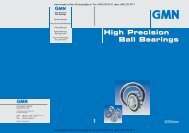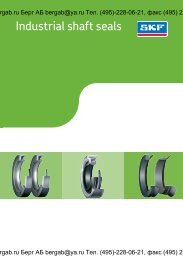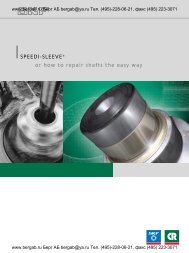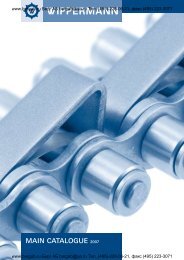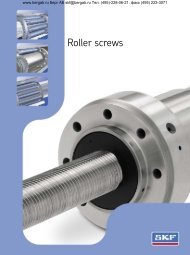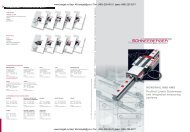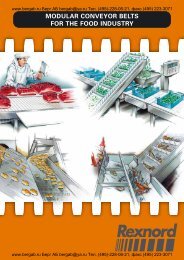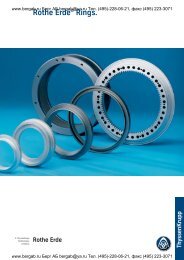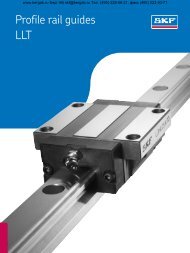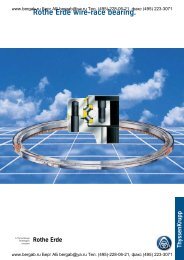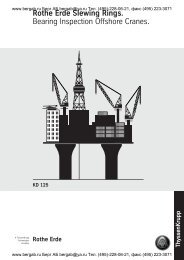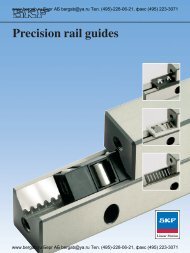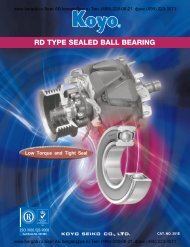You also want an ePaper? Increase the reach of your titles
YUMPU automatically turns print PDFs into web optimized ePapers that Google loves.
www.bergab.ru Берг АБ bergab@ya.ru Тел. (495)-228-06-21, факс (495) 223-3071<br />
Protection for your<br />
customers. Profits for you.<br />
More timing belt applications.<br />
The world’s drivers have continued to press for more<br />
responsive, yet more efficient automobiles. The automotive<br />
industry has responded with efficient, overhead cam,<br />
multi-valve engines driven by timing belts. The dramatic<br />
increase in the use—<strong>and</strong> complexity—of these belts has<br />
created new profit opportunities for garages.<br />
New belt designs.<br />
Generic timing belts, made of st<strong>and</strong>ard materials with<br />
st<strong>and</strong>ard tooth profiles, are a thing of the past. New<br />
generation belts are vastly improved, providing the increased<br />
durability <strong>and</strong> smoother performance characteristics dem<strong>and</strong>ed<br />
by today’s engines—<strong>and</strong> your customers.<br />
Application-specific tooth profiles.<br />
The earliest timing belts had a trapezoidal tooth design. But the need to<br />
meet more dem<strong>and</strong>ing applications resulted in the development of belts with<br />
curvilinear <strong>and</strong> modified curvilinear profiles. These different tooth profiles<br />
are not interchangeable: it is critically important to select the correct belt for<br />
every application.<br />
Trapezoidal<br />
High-performance materials.<br />
Until 1985, the st<strong>and</strong>ard material for timing belts was<br />
neoprene. Today the preferred materials is HSN<br />
(highly-saturated nitrile). Though belts made of HSN<br />
appear no different from neoprene belts, they offer far<br />
better performance in the high-temperature engine<br />
compartments of today’s vehicles. All SKF timing<br />
belts are made of HSN.<br />
Fast Facts<br />
Increased engine dem<strong>and</strong>s required tougher, more durable timing belts.<br />
<strong>Belt</strong>s made of HSN cost more—but the added performance makes them<br />
the best value<br />
<strong>Belt</strong>s may look alike, but they are not interchangeable.<br />
Correct tooth profiles are critical.<br />
120<br />
100<br />
<strong>Timing</strong> belt failure can result in not just inconvenience, but<br />
costly engine damage<br />
The cost of the belt is only 5%-10% of changing the belt.<br />
Your customers will agree that it’s a small price<br />
to pay for peace of mind.<br />
80<br />
60<br />
40<br />
20<br />
0<br />
Cumulative New Applications 1986-1994<br />
New HSN Applications<br />
Exceed Neoprene Applications<br />
Since 1986<br />
(Based on USA Vehicle Sales)<br />
1986 1990 1994<br />
120<br />
100<br />
80<br />
60<br />
40<br />
20<br />
0<br />
Curvilinear<br />
Modified Curvilinear<br />
4 5<br />
www.bergab.ru Берг АБ bergab@ya.ru Тел. (495)-228-06-21, факс (495) 223-3071



